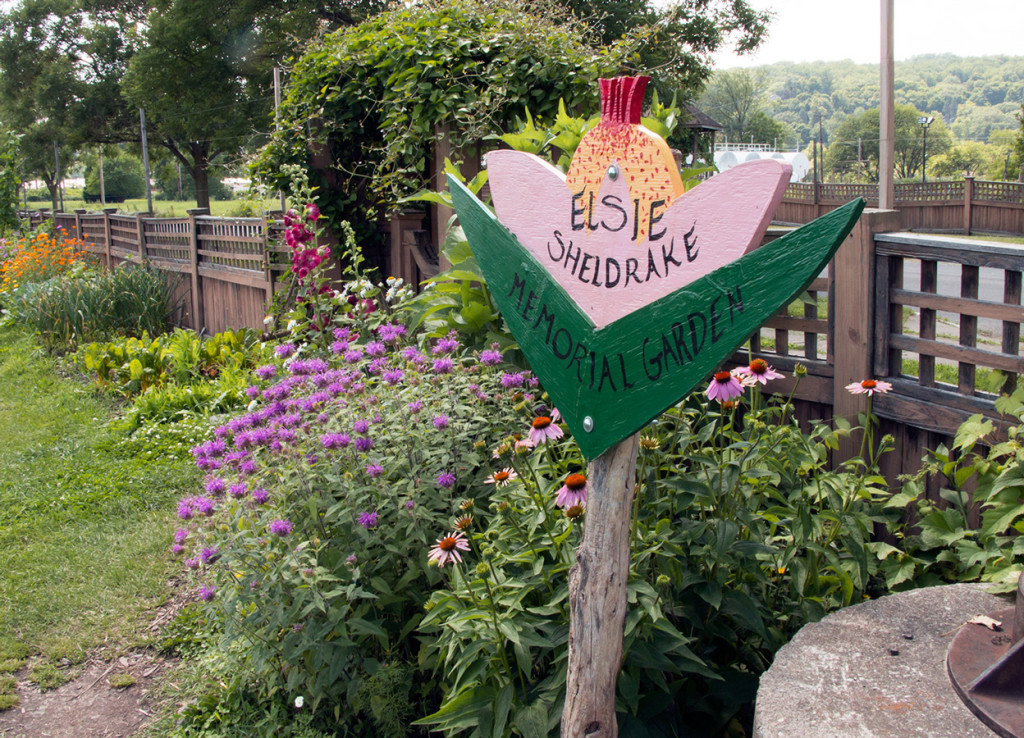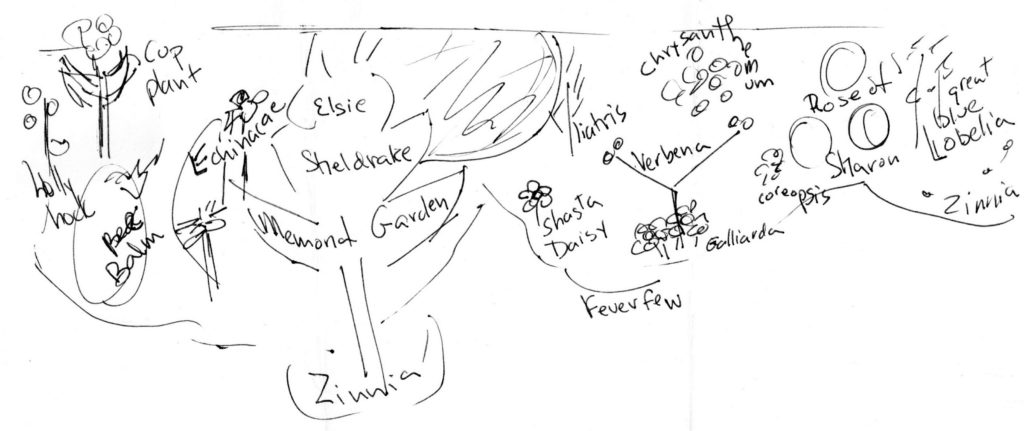Attracting Butterflies in the Elsie Sheldrake Memorial Garden
The wonderful hardworking Elsie Sheldrake of Early Bird Farm on Route 13 was an enthusiastic supporter of the Community Gardens from the 1980s until her death in 2002. Along with an abundance of vegetable plants from her nursery she always donated trays of flowers. She liked to imagine flowers among the vegetables, would tell me that flowers make vegetables grow better. In her honor I have been developing a perennial flower garden. All the plants in the Elsie Garden attract butterflies and other pollinators; once established they’re easy to grow.
 Earlier in the season we had clumps of Shasta daisies that grew taller than the peony bushes behind them. Later blooming are deep red hollyhocks near the lavender bee balm. The daisy-like purple Coneflower (echinacea) has companion daisy forms in the vibrant reds and yellows of rudbeckia and gaillardia. The purple spikes of Blazing Meadowstar (Liatris ligulistylis) will soon be echoed by the spikes of the Great Blue Lobelia (Lobelia siphilitica). The three flowering bushes are called Rose of Sharon, a hardy kind of hibiscus. The 8-foot plant with yellow flowers in the back is Cup Plant (Silphium perfoliatium). Each pair of leaves clasp the stem, making it look like the stem has pierced through them (“perfoliatum”). The leaves form a small cup around the stem in which rain can collect, a barrier to predators climbing the stem.
Earlier in the season we had clumps of Shasta daisies that grew taller than the peony bushes behind them. Later blooming are deep red hollyhocks near the lavender bee balm. The daisy-like purple Coneflower (echinacea) has companion daisy forms in the vibrant reds and yellows of rudbeckia and gaillardia. The purple spikes of Blazing Meadowstar (Liatris ligulistylis) will soon be echoed by the spikes of the Great Blue Lobelia (Lobelia siphilitica). The three flowering bushes are called Rose of Sharon, a hardy kind of hibiscus. The 8-foot plant with yellow flowers in the back is Cup Plant (Silphium perfoliatium). Each pair of leaves clasp the stem, making it look like the stem has pierced through them (“perfoliatum”). The leaves form a small cup around the stem in which rain can collect, a barrier to predators climbing the stem.
New to the Elsie Garden this year is Verbena bonariensis. This purple flowering plant started blooming mid-July. It’s got an airy form, a feel of the wild garden. Besides attracting monarch butterflies, Verbena bonariensis attracts bumble bees, commas, eastern tiger swallowtails, fritillaries, giant swallowtails, hairsteaks, honey bees, hummingbird moths, hummingbirds, painted ladies, red admirals, skippers, sulphurs, and more. The beauty these flying creatures bring to the garden is surpassed only by the health their pollination contributes to the ecosystem. Pollinators are needed for plant reproduction. As they pollinate they produce genetic diversity. This genetic diversity helps plants to adapt to environmental change.
Next season remember Elsie Sheldrake and plant some marigolds among your cucumbers — and then toss the blossoms into a salad. Nasturtium are another easy growing annual that you can eat. If you’re not sure what to grow stroll over to the Farmer’s Market and ask Siri Jones of Magic Garden Plants for suggestions. She’s there most Saturdays with her homegrown flower plants. In the Elsie Sheldrake tradition Siri has taken time from her busy season to donate flowers to the Elsie Garden two years in a row. The gorgeous Shasta daisies, the Verbena bonariensis, the liatris, lobelia, rudbekia and galliardia all came from Siri. Joel and I designed the flower sign with material donated by Doug Dylla and Will Parker. It was hand-lettered and painted by Community Gardener Adam Hollman. The Elsie Sheldrake Garden is really a community project!
–Susan Nassar

